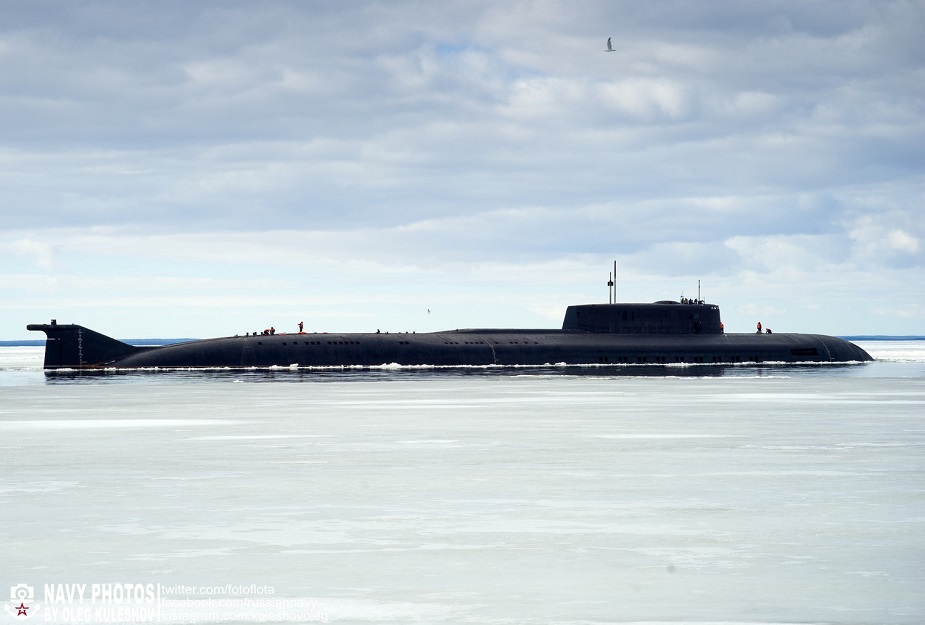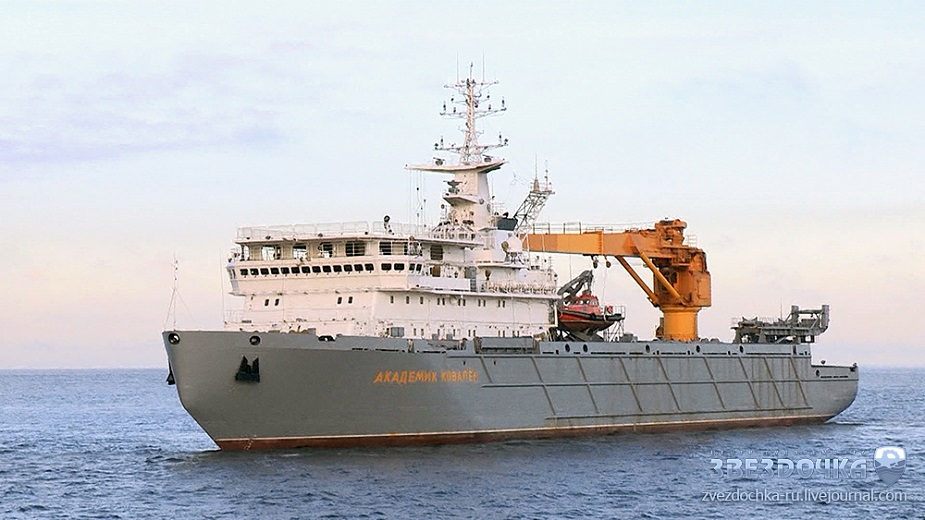In early 2010s the successes in Russian military buildup triggered an euphoria. It was characterized by calls to resume the production of missile-carrying trains, sea skimmers, air-cushioned ships and total upgrade of the fleet inherited from the USSR. However, it should be admitted now that the program had failed, expert Alexander Shishkin writes in the Vzglyad business newspaper.
 Project 949A Antey-class (NATO reporting name: Oscar II-class) nuclear-powered submarine Orel (K-266) sailing out of Zvyozdochka Shipyard on April 6 2017. Picture by Oleg Kuleshov. More pictures at this links.
Project 949A Antey-class (NATO reporting name: Oscar II-class) nuclear-powered submarine Orel (K-266) sailing out of Zvyozdochka Shipyard on April 6 2017. Picture by Oleg Kuleshov. More pictures at this links.
The embarrassment over the 971M project is an isolated incident. The 4-year delay (or may be six years) has become a norm. Overhaul risks are either assessed incorrectly or not assessed at all. The deadlines are set by "believe the contractor" principle and the contractor is interested in obtaining the contract. The best remedy against deliberate decrease of overhaul time is a technical audit of the capabilities of the contractor and subcontractors to fulfil the work.
Today the inconsistency of the "new warship in the old hull" concept and the deep upgrade of project 949A and 971 submarines can be seen with a naked eye.
Had the Defense Ministry and the Navy known the true rather than fictitious deadlines they would have adjusted the plans to speed up the overhaul by minimizing the upgrades (e.g. arming project 971 with Kalibr missiles). The submarines of both projects are not hopelessly outdated and can continue operating until fourth-generation submarines arrive.
The USC chief has recently said in an interview: "Previously the fulfilment of defense procurement orders by the corporation varied in the range of 47-67 percent. In 2017 we achieved sustainable 85-90 percent." Constant delays with defense procurement order make it difficult to believe it. The high ratio is likely achieved by a simple trick.
When the term of the contract expires and the work is still at the initial stage, the customer and the contractor sign an additional agreement to delay the deadline by a year or two. They do it again in a year or two. Thus, the contractor does not breach its commitments, fines are not imposed, and defense procurement order is fulfilled 85-90 percent.
The military are on the bit of the contractor. However, it is time to drop the vicious covering of each other's backs. It would be wrong to fine engineers and ordinary managers, but shipyard CEO and USC president must bear strict personal responsibility.
Had the Russian ship overhaul flourished and supplied the Navy with warships on time, but remained incompletely loaded, there would be nothing wrong if it took other orders. But in current crisis conditions any non-core orders given to the shipyards only aggravate the crisis and are detrimental for the combat capability of the Navy.
 Project 20180 Academician Kovalyov in sea trials. Picture from zvezdochka-ru
Project 20180 Academician Kovalyov in sea trials. Picture from zvezdochka-ru
It is well known that Zvyozdochka shipyard specializes in the overhaul of nuclear submarines. Nevertheless,, despite a long queue of multirole U-boats waiting for the overhaul (8-9 subs) and the protracted overhaul of another four, the shipyard is actively engaged in the construction of supply vessels of project 20180. A report of the shipyard press service shows the resulting damage to the core business. It said close to 500 staff were engaged in the construction of one of the two hulls. It means they were distracted from project 971 upgrade.
Instructions from above triggered a weird situation at Nerpa, which is the second submarine shipyard in the Russian North. After 2015 (when two submarines were completed) Nerpa actually did nothing for two years to overhaul the Vepr and the Tambov. The reasons cited by shipyard CEO A. Oganyan are embarrassing. Although the overhaul of two submarines was not completed, the shipyard fulfilled a contract with the North-West center for nuclear waste treatment and six contracts with Rosatom, including dismantling and unloading of the steam unit of the decommissioned Sibir icebreaker. Oganyan admitted that there are other entities in charge of overhauling and servicing nuclear icebreakers.
It is not the end of the story. The shipyard in Snezhnogorsk, the only one on the Kola Peninsula which mastered complete overhaul of project 971 and 945 submarines, was instructed to convert the first K-3 U-boat of project 971 into a museum (Yantar shipyard was engaged in the same business regarding a decommissioned destroyer while the Neustrashimy overhaul is dragging for six years).
Museum warships are important, but isn’t it appropriate to first restore combat warships and then deal with the legacy? Otherwise the whole Russian Navy risks becoming an affiliate of the Central Naval Museum.
One cannot say that Russian shipyards ran completely idle with interim overhaul, but most of fulfilled orders were either state priorities or long-delayed construction.
The former include SSBN and project 949A SSGN. Breaching of commitments for priority orders will bring nothing good to contractors and they clearly realize it. Therefore, three SSBN (the Yekaterinburg, the Tula and the Ryazan) and three SSGN (the Smolensk, the Oryol, and the Tomsk) commissioned by Zvyozdochka and Zvezda in 2013-2017 do not confirm the effectiveness of the facilities as the submarine overhaul was strictly supervised (and still the Ryazan and the Tomsk spent six years in the shipyard).
The SSN Kuzbass, the Kaluga, the Vladikavkaz, the Komsomolsk-on-Amur diesel-electric submarines, the Marshal Ustinov missile cruiser, the Orsk big landing ship are clear examples of long-delayed overhaul (and not only the shipyards are to blame). Interim overhaul was completed in reasonable time on the Pskov and the Obninsk SSN, the Vyborg and the Dmitrov diesel-electric subs, the Admiral Tributs big antisubmarine warfare ship, the Korolev and the Oslyabya big landing ships. It makes seven warships in five years.
There are less claims to dock, inter-cruise and navigational overhaul, which made Russian warships demonstrate the flag in the World Ocean. Dalzavod, 35th and 13th and some other shipyards deserve praise for that. But unfortunately, it is not enough to rate warship overhaul as satisfactory, expert Alexander Shishkin writes in the Vzglyad newspaper.
© Copyright 2018 TASS. All rights reserved. This material may not be published, broadcast, rewritten or redistributed.










